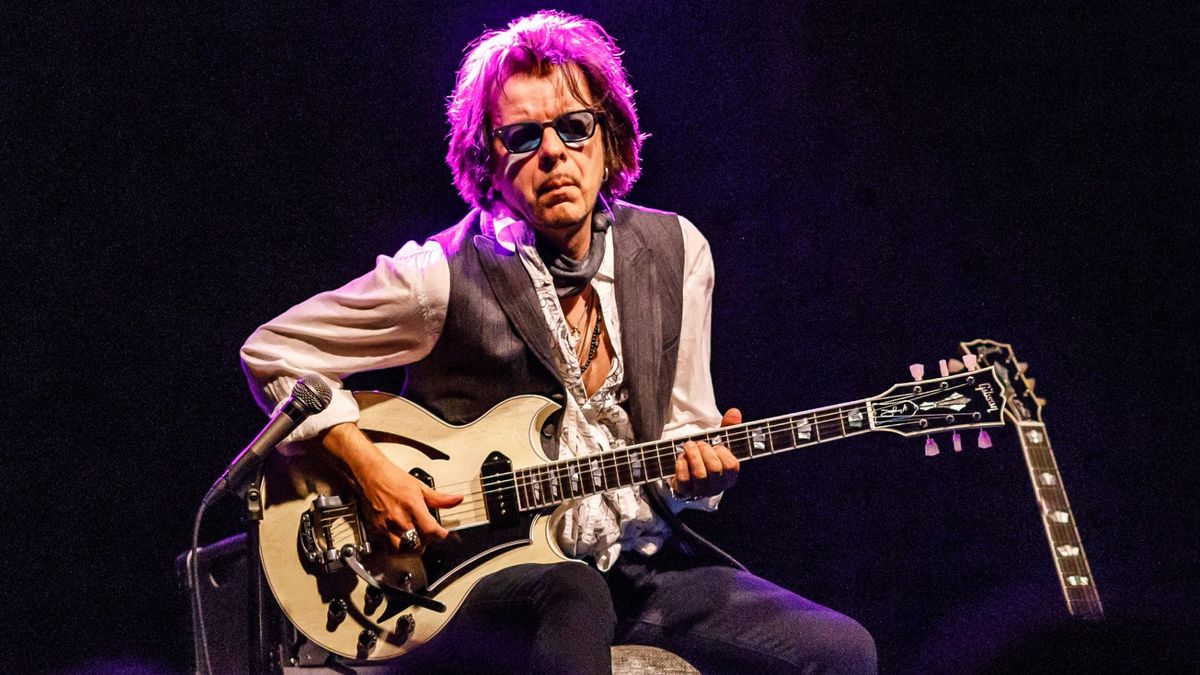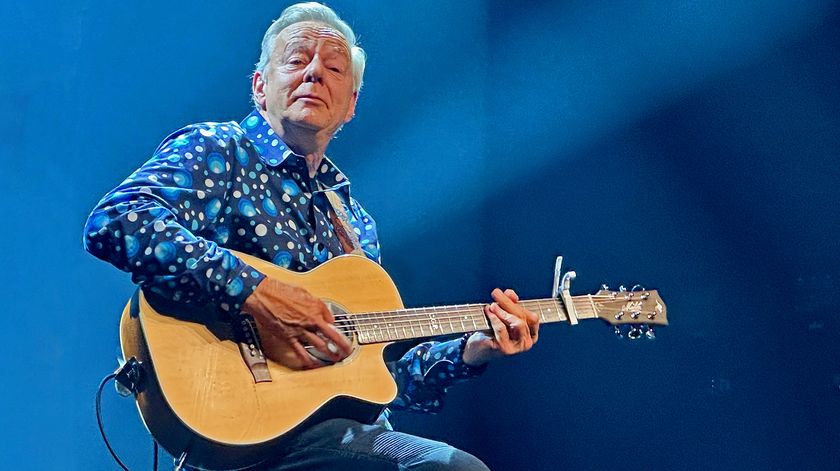Johnny A. Reveals His Live Looping Secrets
With his high-tech looping-based solo show, tasteful tone master Johnny A. conjures a vintage vibe.

Johnny A. built his reputation on taste, tone and chops. And if you ever have a chance to see his live looping act, don’t miss it. He’ll change your idea about what’s possible with an electric guitar.
But seriously: Johnny A.? Looping? “There’s more to the act than just looping,” Johnny explains. “I don’t want a performance to be dynamically linear. It needs to wax and wane, and there’s a limited way to do that as a solo performer with just you and a guitar.”
Although Johnny makes his foray into looping sound like a natural transition, there is more to the story, as he reveals...
What led you to create a solo loop-based act?
I’ve been wanting to do this for quite some time. My family always loved music, and my mother had a piano bar. And like the guy in a piano bar delivering the whole tune to you, I wanted to be able to deliver a song 100 percent on my own. Even though I’m a composer, I based this act on music that inspired me growing up. It’s like a celebration of the British songbook of the ’60s.
I debuted this approach a few years ago on one of Joe Bonamassa’s Keeping the Blues Alive at Sea cruises. I’m not quite as nervous as I was then! I’ve done both Joe’s and [Moody Blues guitarist] Justin Hayward’s cruises as solo gigs. The reaction was very positive, and I enjoyed the process.
How does working solo compare to working with a band?
I was touring for almost 20 years, mostly in a trio, and it got to the point where I wasn’t completely satisfied with the way the music was being represented. At times, the other musicians didn’t seem as emotionally involved or attached, and there were always scheduling conflicts. It was also getting very expensive to put tours together. Then Joe asked me to do his cruise again – I’d already done one – but there was a complication. His office said, “We want you back, but there aren’t enough cabins for your band. Is there anything you can do solo, like a master class?” I decided this was my opportunity to put a solo act together.
Polishing the act was an extremely long process – not just how to master the effects but how to make it like a real show and presentation.
Johnny A.
Working with loops is a challenge, but you make it look easy. Would you say you’re “a natural”?
I’d been trying on and off for five years to do something with loopers, but it wasn’t coming together in a way that I thought was fresh. I didn’t just want to build on a groove and one chord, like most looping artists I’ve seen; I wanted to try to do real songs with traditional structures. Then all of a sudden, one song – Blind Faith’s “Can’t Find My Way Home” – unlocked the key to how I was going to approach it, because it has an A and a B section. I was using the two-channel TC Electronic Ditto X4 looper, and for some reason it just came together. After all that struggling, it just worked. I started to look for other songs that use a similar format.
But how did you get from that “proof of concept” to the finished article?
Polishing the act was an extremely long process – not just how to master the effects but how to make it like a real show and presentation. For the cruise, I needed about 18 songs, and it took almost seven and a half months, rehearsing 12 hours a day, to put the show together.

Now that you have the recipe down, is the process easier?
It’s still complicated. I occasionally go through battles about having the confidence to do it and even have some semi-panic attacks. I’m so used to being on a stage with a band, and going up there by myself is so different, especially because I didn’t want anything pre-recorded. No triggering samples, no pre-recorded loops. True, when I hit the wrong button by accident, it’s all over. This has happened, and it sucks, but I’d rather keep it real. When I play live now, after the second song, I let the audience know in a non-bravado way that everything they’re experiencing is live and in real time.
It’s impressive how you combine a rhythmic, percussive feel with the chords and melodies.
Being a drummer [Johnny started out playing drums], I have a strong sense of rhythm and a good sense of timing. I program the echoes to take advantage of palm mutes, ghost notes, et cetera, to create what sounds like percussion tracks.
You need an impeccable sense of timing, not just as a player but also when you’re recording or triggering a loop.
Johnny A.
With nothing pre-recorded, it must be tough to keep the rhythm tight.
That’s the biggest challenge. You need an impeccable sense of timing, not just as a player but also when you’re recording or triggering a loop. These loops aren’t quantized; the only rhythmic reference is that each song has a tempo programmed into it so the echoes are in time with the bpm. The loop-in and loop-out points have to be really on, as does turning the effects on and off. If the echoes are wrong, it gets messy, but if they’re on time you sense the rhythm more than the echoes.
You clearly pay as much attention to the arrangement as to the timing.
I want to have variations. That keeps the act interesting. I can create the equivalent of “background vocals” with one effect, go from stereo to mono for the melody so it comes down the middle, keep the rhythm on the sides, and add the low-octave bass sound in the center. I try to add “ear candy” elements for production, like a rotary-speaker effect or strings, as if I’m working with a vocal arrangement.

What’s your gear lineup?
There are two TC Electronic Ditto X4 loopers, but only one is in use at any given moment. One looper is in Sync mode, where you can record separate loops that play back simultaneously. The other looper is in Series mode, where I can record an A section and a B section and go back and forth between them. Another reason for the two loopers is if one goes down, I have a spare onboard. The only effects I use on the loopers are the Backward and Fade modes.
For processing, the [Fractal Audio] Axe-Fx III works best for this situation. I use three parallel amp paths: one guitar amp with a typical signal chain; a bass amp path with an octave-divider effect, its own amp/cab and compressor, and no guitar effects; and the third path with sounds similar to string effects. Also, the Axe-Fx III has an effects loop, where I have an SSL XLogic G Series bus compressor on the main outputs. The three signal paths combine and go into the looper pre-compressor, and then into the PA.
Do you use an FRFR [Full Range, Flat Response] system?
Most gigs have professional sound systems, but when I do private functions or smaller venues, I provide the sound with a pair of Bose L1 Model IIs, along with a ToneMatch four-channel mixer and the S1 Multi-Position PA for monitoring. Everything merges together into two line outs. I used Bose before the solo act. I’ve had the system for a couple of years.
I think part of the reason why it took so long to get this act together is I kind of had to wait for the technology to catch up.
Johnny A.
Do you use guitar amps too?
I don’t use conventional amps for this. I was going to use my hand-wired Marshall JTM45s. They sounded great. But with multiple layering of loops, the KT66 tubes didn’t recover fast enough. The sound got smaller.
I think part of the reason why it took so long to get this act together is I kind of had to wait for the technology to catch up. The Ditto loopers and the Axe-Fx III are so much better than the previous versions. I’m a real “tube amp, vintage guitar” kind of guy. Nothing is organic in my setup. But if you approach sound with analog ears, then that’s the sound you’ll obtain
Discover more music by Johnny A. here.
Get The Pick Newsletter
All the latest guitar news, interviews, lessons, reviews, deals and more, direct to your inbox!

"Jaco thought he was gonna die that day in the control room of CBS! Tony was furious." John McLaughlin on Jaco Pastorius, Tony Williams, and the short and tumultuous reign of the Trio of Doom

“It’s all been building up to 8 p.m. when the lights go down and the crowd roars.” Tommy Emmanuel shares his gig-day guitar routine, from sun-up to show time










